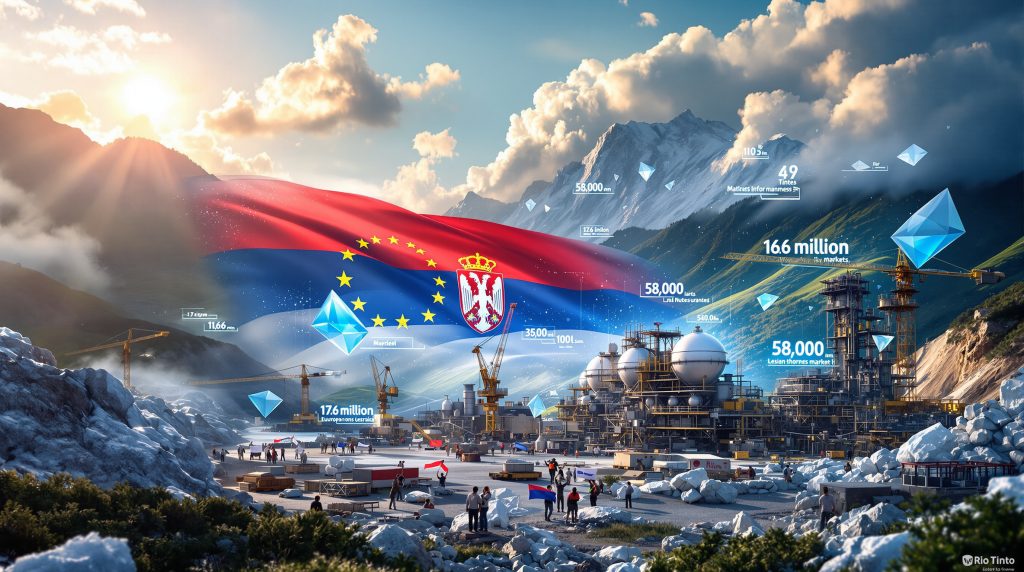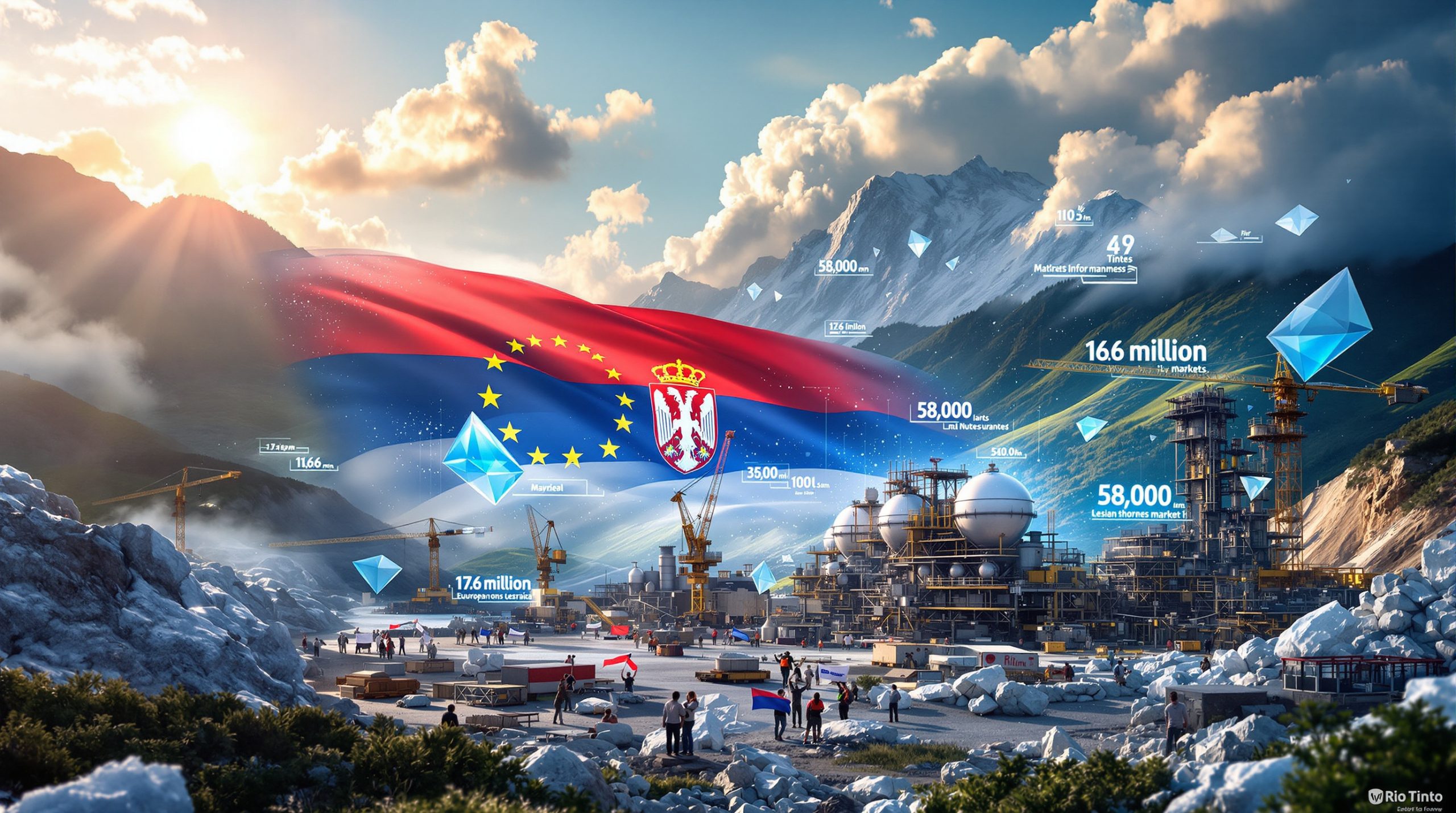Strategic Collapse: Why Rio Tinto Halts Flagship Lithium Project in Serbia
Rio Tinto halts flagship lithium project in Serbia represents one of the most significant setbacks in the global race to secure critical battery materials. The mining giant's decision to indefinitely suspend development at its flagship European operation demonstrates how complex regulatory challenges and community opposition can derail even the most strategically important projects. This comprehensive analysis examines the multifaceted challenges that forced one of the world's largest miners to step back from what could have been Europe's most important lithium source.
Understanding the Jadar Project's Strategic Importance
What Made Jadar Europe's Most Promising Lithium Development?
The suspended Serbian operation contained extraordinary resource potential that positioned it as a cornerstone of European energy independence. Located in western Serbia's Jadar valley, this deposit held proven reserves of 16.6 million tonnes of lithium-borate ore with an exceptional 1.8% lithium oxide grade significantly higher than most global competitors.
According to the U.S. Geological Survey Critical Minerals Summary for Lithium (2024), most operating hard rock lithium mines globally operate at grades between 0.8-1.5% lithium oxide. The Jadar deposit's grade positions it among higher-quality hard rock resources, though still lower than elite deposits like Greenbushes in Australia at approximately 2.0% spodumene.
Key Resource Metrics:
- Total lithium reserves: 16.6 million tonnes of ore
- Grade quality: 1.8% lithium oxide (above industry average)
- Planned annual output: 58,000 tonnes lithium carbonate
- Processing complexity: Lithium-borate ore requiring specialised extraction methods
- Discovery timeline: Project identified in 2004, developed over two decades
The lithium-borate ore classification indicates the deposit contains lithium incorporated within borate minerals, requiring specific processing methodologies different from standard spodumene (hard rock) or lithium extraction methods. This specialised processing requirement represents a technical complexity factor that distinguishes Jadar from more conventional lithium sources.
Co-Product Revenue Streams:
| Product | Annual Volume | Market Applications |
|---|---|---|
| Lithium carbonate | 58,000 tonnes | Battery manufacturing |
| Boric acid | 286,000 tonnes | Industrial processes |
| Sodium sulfate | 255,000 tonnes | Chemical production |
How Did This Project Fit Into Rio Tinto's Portfolio Strategy?
The suspension occurs within a broader corporate restructuring under CEO Simon Trott, who assumed leadership in August 2025. Following Rio Tinto's $6.7 billion acquisition of Arcadium Lithium, the company has been consolidating its battery materials division while prioritising projects with clearer regulatory pathways.
Industry participants confirm that regulatory complexity became insurmountable even for a major multinational corporation with significant financial and technical resources. Furthermore, market sources noted Rio Tinto no longer could justify the required expenses and resource allocation given delays in the permitting process.
This strategic pivot reflects industry-wide adjustments as lithium prices remain 85% below their 2022 peaks due to global oversupply conditions. According to Benchmark Mineral Intelligence data, lithium carbonate spot prices have declined from approximately $80,000 per tonne in November 2022 to trading ranges of $12,000-$15,000 per tonne in Q4 2025.
Current Rio Tinto Lithium Portfolio:
- Argentina: Rincon project under development
- Chile: Two major mining concessions secured
- Inherited assets: Three operational projects from Arcadium acquisition
- Strategic focus: Operational efficiency and capital allocation discipline
The Regulatory Maze: Why Permits Became Insurmountable
What Specific Permitting Challenges Halted Progress?
The project encountered a complex web of regulatory obstacles spanning multiple government levels and environmental agencies. Despite initial approvals, the Serbian government suspended all activities in early 2022 following widespread public opposition.
Timeline of Regulatory Developments:
- 2017: Initial memorandum of understanding signed with Serbian government
- 2022: Project suspended amid mass environmental protests
- 2024: Constitutional Court reinstated Rio Tinto's licenses
- September 2024: Public consultation period reopened
- November 2024: Environmental Impact Assessment requirements issued
- November 2025: Rio Tinto halts flagship lithium project in Serbia
The 8-year timeline from initial MOU (2017) to indefinite suspension (2025) without final operational approval demonstrates permitting complexity severity. For context, typical lithium project development timelines range from 5-7 years under favourable regulatory conditions.
The November 2024 Environmental Impact Assessment requirements indicated Serbian regulators demanded comprehensive environmental documentation covering groundwater hydrology and contamination risk modelling, air quality impact assessments, agricultural land impact studies, habitat and biodiversity surveys, and cumulative environmental impact analysis.
How Did Political Dynamics Influence the Decision?
Local and national political pressures created an environment where regulatory approval became increasingly unlikely. Environmental groups organised sustained campaigns highlighting potential groundwater contamination and habitat destruction risks.
Mass demonstrations beginning in 2021 created sustained political pressure that transcended typical environmental activism. The movement gained momentum by connecting local environmental concerns with broader questions about foreign corporate influence in Serbian natural resources.
The 2022 suspension despite existing governmental agreements demonstrates Serbian government determination to align with constituent environmental preferences even when contradicting international commercial commitments.
However, the European Commission's designation of Jadar as one of 13 strategic critical material projects under the Critical Raw Materials Act added geopolitical complexity, making the project a symbol of broader debates about resource sovereignty and environmental protection.
Financial Implications: Breaking Down the Investment
What Were the Project's Economic Fundamentals?
Rio Tinto had committed $2.4 billion to develop the operation, with construction costs estimated at €2.55 billion for full operational capacity by 2027. The financial model depended on sustained lithium demand growth and pricing stability that has not materialised.
At current market prices (November 2025), projected revenue streams suggest:
- Lithium carbonate: $12,000-$15,000/tonne = $696-$870 million annual revenue potential
- Boric acid: ~$400-$500/tonne = $114-$143 million annual revenue
- Sodium sulfate: ~$150-$200/tonne = $38-$51 million annual revenue
This projection suggests total annual revenue potential of approximately $850-$1,064 million at current pricing, representing 3-4 year payback periods on capital investment under optimistic scenarios.
Project viability models depend critically on lithium price assumptions, with breakeven pricing likely requiring $20,000-$25,000 per tonne given high development and operational costs. By-product value realisation requires customer offtake certainty, while remote location necessitates infrastructure development costs affecting per-unit production expenses.
How Do Current Market Conditions Affect Project Viability?
The suspension coincides with challenging lithium market fundamentals. Oversupply from established Australian, Chilean, and Argentinian producers has created pricing pressure that makes new, complex developments less attractive to investors.
According to Benchmark Mineral Intelligence (November 2025), global lithium production capacity has outpaced demand growth, creating current production of approximately 1.2 million tonnes lithium carbonate equivalent annually, with demand growth rate at 10-15% annually versus supply growth rate at 20-25% annually.
One market source noted that projects requiring extensive community engagement and environmental mitigation face higher development costs, making them vulnerable during market downturns. Another source indicated Rio was essentially losing money annually maintaining the project, making suspension economically rational.
In addition, this supply-demand mismatch creates pricing pressure with established producer expansion from Pilbara Minerals and Mineral Resources in Australia, increased Chinese production growth in hard rock lithium processing, and new project ramp-up affecting global market balance.
Community Opposition: Understanding Local Resistance
What Environmental Concerns Drove Public Opposition?
Local communities raised substantive concerns about the project's potential environmental impact, particularly regarding groundwater systems and agricultural land use. The Jadar valley's agricultural significance made residents particularly sensitive to any industrial development.
Primary Community Concerns:
- Groundwater contamination risks affecting agricultural irrigation systems
- Agricultural land displacement impacting farming-dependent local economy
- Air quality impacts from large-scale processing operations
- Long-term habitat disruption affecting regional biodiversity
- Industrial traffic through rural communities increasing logistics burden
The region's designation as requiring agricultural sensitivity indicates the area's farming-dependent economy, where groundwater quality and soil integrity represent primary livelihood assets for resident populations. Furthermore, the outlined emphasis on groundwater systems suggests the deposit's location within significant aquifer zones, potentially affecting downstream water supply for agricultural and municipal purposes.
How Did Protest Movements Influence Government Policy?
Environmental activism successfully influenced government policy, leading to the initial 2022 suspension despite existing agreements with Rio Tinto. The movement transcended typical environmental concerns to address broader questions about resource sovereignty and corporate accountability in post-transition Balkan politics.
These protests created recognisable patterns in Balkans region resource politics where foreign mining investment intersects with anxieties regarding resource sovereignty and corporate accountability. Consequently, the sustained political pressure forced governmental alignment with constituent preferences over international commercial commitments.
European Energy Security: Broader Strategic Implications
What Does This Suspension Mean for EU Critical Materials Strategy?
The Jadar project's halt significantly complicates European efforts to reduce dependence on Chinese lithium processing and establish domestic supply chains. The EU's Critical Raw Materials Act specifically identified such projects as essential for strategic autonomy.
According to the European Raw Materials Alliance 2024 report, the EU currently imports approximately 90% of its lithium supply, primarily from Chile (35-40%), Argentina (30-35%), and Australia (15-20%). Moreover, the critical minerals energy transition requires secured supply chains to meet ambitious decarbonisation targets.
European Lithium Supply Chain Impact:
- Increased reliance on Australian and South American imports
- Greater dependence on Chinese processing capabilities
- Delayed timeline for European battery manufacturing independence
- Higher supply chain costs for EU automakers
- Strategic vulnerability in critical materials procurement
The suspension creates dual political pressures: EU-level interest in domestic supply security versus local sovereignty and environmental protection concerns. For instance, this contradiction between EU critical materials security objectives and EU environmental protection directives regarding mining represents ongoing policy tensions.
How Will This Affect Global Lithium Market Dynamics?
The suspension removes a potential major supply source from medium-term market forecasts, though current oversupply conditions minimise immediate price impacts. However, long-term supply security becomes more concentrated among existing producers.
Established lithium producers in Australia (particularly Pilbara Minerals and Mineral Resources) and South America may benefit from reduced future competition. The market participant assessment indicates mature, operational projects with established cost structures can operate profitably at lower prices, while development projects face fixed capital charges requiring higher breakeven pricing.
Rio Tinto's Strategic Pivot: Alternative Opportunities
What Other Lithium Assets Does Rio Tinto Control?
Following the Arcadium Lithium acquisition, Rio Tinto maintains significant lithium exposure through operational projects with clearer regulatory pathways. The company's restructuring designated lithium as one of Rio Tinto's main divisions, indicating strategic commitment to battery materials despite Jadar suspension.
Current Portfolio Composition:
- Rincon project (Argentina): Under active development
- Chilean concessions: Two major mining rights secured for future production
- Arcadium inheritance: Three operational projects providing immediate cash flow
- Regional diversification: Reduced dependency on single-country regulatory risk
How Does This Decision Align With CEO Simon Trott's Vision?
The suspension reflects Trott's focus on operational efficiency and capital allocation discipline. His strategy prioritises projects with established regulatory frameworks and community acceptance over potentially higher-return but riskier developments.
This approach mirrors broader industry trends toward de-risking project portfolios amid volatile commodity markets. The timeline indicates approximately three months between restructuring announcement and suspension decision, suggesting rapid strategic reorientation under new leadership. Furthermore, this reflects ongoing mining industry evolution toward more selective project development.
Looking Forward: Potential for Future Development
Could the Jadar Project Resume Under Different Conditions?
Rio Tinto maintains that it views Jadar as a significant lithium deposit that could eventually contribute to Serbia's energy transition. The company has placed the project in care and maintenance mode rather than permanently abandoning it.
Future development would require sustained improvement in lithium market conditions, resolution of community concerns through enhanced engagement, streamlined regulatory processes, and political stability supporting foreign mining investment. In addition, the broader European context includes the European CRM facility initiative, which could provide alternative supply security.
Prerequisites for Potential Resumption:
- Market recovery: Lithium prices returning to $25,000+ per tonne sustainably
- Regulatory clarity: Defined timeline and requirements for final approval
- Community engagement: Comprehensive stakeholder agreement on environmental protection
- Political stability: Consistent governmental support across electoral cycles
- Technical innovation: Improved processing methods reducing environmental impact
What Lessons Does This Provide for Future Critical Minerals Projects?
The Jadar suspension highlights the increasing importance of social licence and community engagement in modern mining development. Technical and financial feasibility alone cannot ensure project success without addressing local concerns and environmental impacts.
Key Industry Takeaways:
- Early community engagement is essential for long-term project success
- Environmental impact mitigation must be comprehensive and transparent
- Regulatory risk assessment requires political stability analysis
- Market timing significantly affects development project viability
- Portfolio diversification reduces single-project dependency risks
- Social licence increasingly determines mining project outcomes
The outcome emphasises that successful mining development in the 21st century requires not just geological and financial viability, but also genuine social licence and environmental stewardship. As the global energy transition continues, companies must navigate these multifaceted challenges to develop the critical materials needed for renewable energy systems while respecting community values and environmental protection.
Market Psychology and Investment Implications
The Jadar suspension reveals critical insights about modern mining investment psychology. Market participants demonstrate increasing sophistication in evaluating projects across technical, regulatory, and social dimensions simultaneously, rather than treating regulatory approval as administratively inevitable.
The timing of Rio Tinto's decision reflects broader industry recognition that permitting complexity and social opposition create sustained operational costs even during development phases. Annual maintenance costs including licensing, environmental monitoring, and minimal staffing became unjustifiable against uncertain commercialisation timelines and depressed market fundamentals.
Investment Strategy Considerations:
- Regulatory risk premium: Development projects in contested regions require higher return thresholds
- Social acceptance evaluation: Community engagement quality affects long-term project viability
- Market cycle timing: Development decisions increasingly sensitive to commodity price cycles
- Operational portfolio balance: Mixing development and operational assets reduces volatility
For investors and industry observers, the Jadar suspension serves as a reminder that resource development timelines and success rates depend increasingly on social and political factors alongside traditional technical and economic considerations. Moreover, the global energy transition requires not just geological resources, but also sustainable development approaches that balance industrial needs with community values and environmental protection.
How Do Current Conditions Affect Other Mining Projects?
The suspension has broader implications for mining companies navigating similar regulatory environments. Industry analysts suggest that projects lacking strong community support or facing significant environmental opposition may face increased scrutiny from investors and lenders.
Additionally, the decision reinforces how lithium industry tax breaks in more mining-friendly jurisdictions like Australia become increasingly attractive to developers seeking predictable regulatory pathways.
According to recent industry reports from Reuters, the sustained protests throughout 2024 demonstrated the power of organised community opposition in influencing corporate decisions, even for major multinational mining companies.
The case study of Rio Tinto halts flagship lithium project in Serbia will likely influence how mining companies approach community engagement and environmental assessment in future critical minerals projects. For instance, companies may need to allocate significantly more time and resources to stakeholder consultation during early project phases.
Consequently, the suspension represents more than just one company's strategic decision—it signals a fundamental shift in how the mining industry must balance commercial objectives with social and environmental considerations in the modern era.
Disclaimer: This analysis contains forward-looking statements and market assessments that involve inherent risks and uncertainties. Commodity prices, regulatory decisions, and project development timelines can vary significantly from projections. Readers should conduct independent research and consult qualified advisors before making investment decisions based on this information.
Ready to Capitalise on the Next Major Mineral Discovery?
Discovery Alert's proprietary Discovery IQ model provides instant notifications when significant ASX mineral discoveries are announced, transforming complex mining data into actionable investment insights for traders and investors. Explore how historic discoveries can generate substantial market returns and begin your 30-day free trial today to position yourself ahead of market-moving announcements.




